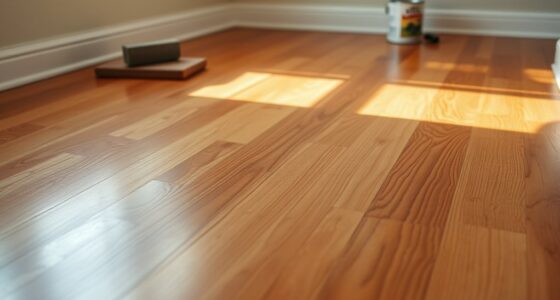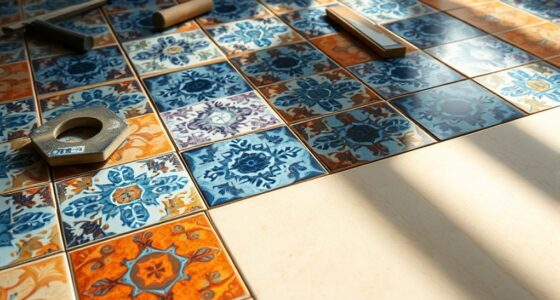To brighten up your space with lighting design, focus on balancing natural and artificial light. Open curtains to let in sunlight, and use mirrors to reflect light. Layer your lighting with ambient, task, and accent types to add depth. Choose warmer tones for cozy areas and cooler tones for vibrant workspaces. Don’t overlook fixture design; it can enhance your room’s aesthetic. If you want to discover more tips and tricks, keep exploring!
Key Takeaways
- Maximize natural light by opening curtains and using mirrors to reflect sunlight, enhancing brightness and mood in your space.
- Layer different lighting types, combining ambient, task, and accent lighting to create depth and visual interest throughout the room.
- Choose warm color temperatures for cozy areas and cooler tones for workspaces to optimize the atmosphere and functionality of each space.
- Incorporate dimmers and decorative fixtures that complement your decor style, enhancing both lighting effectiveness and aesthetic appeal.
- Strategically place table lamps and wall sconces to provide targeted lighting for specific tasks while highlighting architectural features or artwork.

Have you ever walked into a room and felt instantly at ease, or perhaps a bit on edge? The difference often comes down to lighting design. It’s amazing how the right light can transform a space and influence your mood. Whether you’re hosting a gathering or simply unwinding after a long day, understanding how to manipulate lighting can make all the difference.
Start by considering the purpose of each room. For a cozy living area, you might want soft, warm lighting that encourages relaxation and conversation. Think about using floor lamps with dimmers or string lights to create that inviting glow. On the other hand, if you’re designing a workspace, you’ll want bright, focused lighting to enhance concentration and productivity. A well-placed desk lamp or overhead light can keep you energized and alert.
Consider each room’s purpose: soft, warm lighting for relaxation, bright lighting for productivity. Create the perfect atmosphere with thoughtful choices.
Don’t underestimate the power of natural light, either. Whenever possible, let the sun shine in! Open those curtains and allow daylight to flood your space. Natural light not only helps you feel more connected to the outside world but also has positive effects on your mood and health. If you’re in a space with limited windows, consider mirrors. Placing mirrors strategically can reflect light and make a room feel larger, brighter, and more open.
Layering your lighting is another key element. You shouldn’t rely on just one type of light source. Combine ambient lighting, task lighting, and accent lighting to create depth and dimension. For example, use overhead fixtures for general illumination, table lamps for specific tasks, and wall sconces to highlight artwork or architectural features. This approach not only makes your space functional but also visually interesting.
Color temperature matters, too. Warmer tones, like those found in incandescent bulbs, create a cozy atmosphere, while cooler tones mimic daylight and promote alertness. Think about the mood you want to set and choose your bulbs accordingly. You can even mix different temperatures in a room to create variety. Additionally, consider how color accuracy can enhance your visual experience, especially if your lighting design includes projectors or screens.
Finally, don’t forget about the fixtures themselves. The design of your light fixtures can contribute noticeably to your overall aesthetic. Choose styles that complement your decor, whether that’s sleek and modern or rustic and charming. With thoughtful lighting design, you can truly brighten up your space and enhance your experience in it. So, take a moment to reassess your lighting and see how you can make your environment work better for you.
Frequently Asked Questions
How Do I Choose the Right Light Bulbs for My Fixtures?
To select the right light bulbs for your fixtures, start by checking the wattage and type of bulb your fixture requires. Consider the color temperature; warmer tones create a cozy atmosphere, while cooler tones brighten spaces. Opt for energy-efficient options like LED bulbs to save on electricity. Finally, think about the bulb’s shape and size to make certain it fits your fixture perfectly. Experiment with different bulbs to find the ambiance you love!
What Is the Difference Between Warm and Cool Light Temperatures?
Imagine stepping into a cozy café, where warm light wraps around you like a soft blanket. Warm light temperatures (2700K-3000K) create a relaxed atmosphere, perfect for winding down. On the other hand, cool light temperatures (4000K-5000K) mimic daylight, energizing your space and enhancing focus, much like a bright morning. Choosing between them depends on your mood and the activity; warm lights are for relaxation, while cool lights boost productivity.
How Can I Create a Layered Lighting Effect in My Home?
To create a layered lighting effect in your home, start by combining ambient, task, and accent lighting. Use overhead fixtures for general illumination, add table or floor lamps for tasks like reading, and incorporate wall sconces or decorative lights to highlight artwork or architectural features. Vary the brightness and color temperatures to enhance the mood. Experiment with dimmers to adjust intensity, ensuring each layer complements the others and creates a warm, inviting atmosphere.
What Are the Best Lighting Options for Small Spaces?
For small spaces, you’ll want to focus on lighting options that maximize brightness without overwhelming the area. Opt for wall sconces and pendant lights to save floor space. Use mirrors to reflect light, making the space feel larger. Consider LED strip lights under shelves or cabinets for a modern touch. Also, choose lighter shades for lampshades to diffuse light effectively. Dimmer switches can help you adjust brightness based on your needs.
How Do I Maintain and Clean My Light Fixtures Effectively?
Think of your light fixtures as stars in your home’s galaxy. To keep them shining bright, dust them weekly with a microfiber cloth. For deeper cleaning, turn off the power and remove bulbs if possible. Wipe surfaces with a damp cloth and a gentle cleaner, avoiding harsh chemicals. For intricate designs, use a soft brush to reach hidden corners. Reassemble everything once dry, and bask in the glow of your refreshed fixtures!
Conclusion
Incorporating thoughtful lighting design can transform any space, making it feel more inviting and functional. Did you know that well-placed lighting can boost your mood by up to 20%? By choosing the right fixtures, layering light sources, and considering color temperatures, you can create an atmosphere that enhances your daily life. So, don’t underestimate the power of lighting; let it brighten up your space and elevate your overall well-being!









